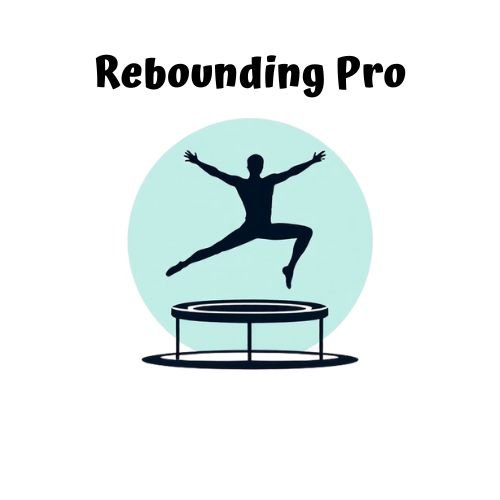Rebounding workouts skyrocket fat loss because they burn up to 12.4 calories per minute while creating a powerful afterburn effect that continues for hours post-exercise. You’ll engage almost every muscle group simultaneously, including deep core muscles, while the low-impact surface protects your joints and encourages consistency. The unique up-and-down motion specifically targets stubborn visceral fat by balancing hormones like cortisol and insulin. Discover how this efficient exercise method can transform your metabolism more effectively than traditional cardio.
The Science Behind Rebounding’s Calorie-Burning Power

Rebounding offers an impressive calorie-burning punch that many fitness enthusiasts overlook. This powerful exercise burns between 6.9 to 12.4 calories per minute, meaning you’ll torch about 223 calories during a 30-minute moderate session if you weigh 155 pounds.
Bounce your way to better fitness—rebounding burns more calories in less time than most people realize.
Your results scale with your commitment—a 140lb woman can burn approximately 405 calories in just 40 minutes. That’s equivalent to what you’d burn during a much longer jogging session, as 20 minutes on a rebounder equals 30 minutes of running.
What makes rebounding so effective is its high-impact nature and full-body muscle engagement, which elevates your heart rate and metabolism more efficiently than many low-impact alternatives. As demonstrated in our controlled study, heavier individuals tend to burn significantly more calories during identical workouts.
Your weight, age, and intensity level will influence your exact calorie burn, but the metabolic boost is undeniable.
How Rebounders Activate Multiple Muscle Groups Simultaneously
When you bounce on a rebounder, your body engages nearly every muscle group from your calves to your shoulders, creating a full-body workout in minimal time.
Your core muscles continuously activate to maintain balance on the unstable surface, while your arms and legs work in coordinated patterns during movements like twisting jumps and speed skaters.
This simultaneous muscle engagement increases your workout efficiency, as you’re strengthening and toning multiple areas at once rather than isolating individual muscle groups. The variable intensity programming makes rebounding suitable for people of all fitness levels, allowing anyone to benefit from this efficient muscle-activating exercise.
Full-Body Activation
Unlike traditional exercise equipment that often isolates muscle groups, mini-trampolines engage your entire body in a synchronized effort with every bounce.
When you rebound, your legs and glutes power each jump while your core muscles stabilize your movements and maintain balance.
Your arms and shoulders aren’t just along for the ride—they actively participate when you incorporate arm waves or resistance exercises.
Meanwhile, your back muscles work continuously to maintain proper posture during your workout.
This thorough muscle recruitment notably increases your caloric burn while improving coordination as different muscle groups work together.
Despite the intensity, you’ll enjoy a lower impact on your joints compared to running or jumping on hard surfaces.
The result is a more efficient workout that stimulates your metabolism and supports fat loss without unnecessary stress on your body.
Adding specific techniques like squats and lunges on the rebounder further increases muscle activation for optimal fat-burning results.
Core-To-Extremity Engagement
The secret to rebounding’s extraordinary fat-burning potential lies in its unique core-to-extremity activation pattern. When you bounce, your deep core muscles—including your pelvic floor—engage instantly to stabilize your body, while your limbs work simultaneously to control movement.
This integrated muscle recruitment creates a powerful synergy: your core acts as the command center while your arms and legs execute movements, burning more calories than isolated exercises.
The unstable surface triggers your proprioceptors, forcing continuous micro-adjustments that activate often-neglected stabilizer muscles.
You’ll experience a blend of isometric core contractions with plyometric limb actions, enhancing both muscular endurance and power.
This combination optimizes neuromuscular efficiency, improving coordination between muscle groups and accelerating your body’s fat-burning mechanisms through thorough, connected activation. Rebounding significantly enhances bone mineral density, making it an excellent option for those concerned about osteopenia while pursuing fat loss goals.
Comparing Rebounder Workouts to Traditional Cardio

Many fitness enthusiasts wonder if bouncing on a mini-trampoline can truly replace their tried-and-true treadmill sessions or cycling classes. The evidence suggests rebounders hold their own—and often excel—in several key areas.
You’ll burn 250-400 calories per hour on a rebounder while considerably reducing joint stress compared to running. Unlike high-impact exercises, rebounding protects your body with its springy surface that absorbs shock. Your heart rate elevates just as effectively, delivering comparable cardiovascular benefits in potentially shorter sessions.
What sets rebounding apart is its full-body engagement, especially in your core, combined with lymphatic circulation benefits you won’t get from traditional cardio.
Perhaps most importantly, you’re more likely to stick with rebounding because it’s genuinely fun—it feels like a dance party rather than a workout. This enjoyment factor leads to greater consistency, which ultimately drives better fat loss results.
The Metabolic Afterburn Effect of Rebounding Sessions
Your rebounder workout ignites a metabolic fire that continues burning calories long after you’ve stepped off the trampoline.
This afterburn effect, scientifically known as EPOC (Excess Post-Exercise Oxygen Consumption), can keep your body burning extra calories for up to 24 hours following your rebounding session.
You’ll benefit from this metabolic boost even while you’re sitting at your desk or sleeping, making rebounding an exceptionally efficient choice for maximizing fat loss with minimal time investment. The NASA study found that just 10 minutes rebounding provides equivalent cardiovascular benefits to 30 minutes of running, making it one of the most time-efficient workouts available.
Metabolic Fire Continues
Metabolic fire burns long after you’ve stepped off the rebounder, thanks to a phenomenon known as Excess Post-Exercise Oxygen Consumption (EPOC).
This afterburn effect can last hours or even up to three days following your high-intensity rebounding session, continuously torching calories while you go about your day. However, research indicates that claims of extended afterburn lasting 24+ hours are often greatly exaggerated, as most significant calorie burn occurs during and immediately after exercise.
The intensity of your rebounding workout directly impacts your metabolic boost. When you bounce vigorously, you trigger powerful hormonal and enzymatic responses that maintain your elevated metabolism during recovery.
- Your body expends significant energy repairing muscles and replenishing energy stores
- Hormones like epinephrine and growth hormone continue stimulating fat breakdown
- Increased protein synthesis for muscle building keeps your calorie burn elevated
This sustained metabolic elevation transforms your body into a fat-burning machine even at rest.
EPOC Beyond Exercise
While your rebounding session may last only 20-30 minutes, the fat-burning effects can continue for hours—even days—after you’ve finished. This phenomenon, known as Excess Post-Exercise Oxygen Consumption (EPOC), transforms your body into a calorie-burning machine long after you’ve stepped off the rebounder. According to research, participants on mini-trampolines achieved cardiorespiratory fitness levels that meet ACSM guidelines while perceiving the workout as less intense.
| EPOC Duration | Intensity Level | Calorie Impact |
|---|---|---|
| 2-4 hours | Low-moderate | 50-100 extra |
| 12-24 hours | High-intensity | 150-250 extra |
| 24-48 hours | Maximum effort | 200-300+ extra |
The key to maximizing this afterburn lies in workout intensity rather than duration. By incorporating short bursts of all-out effort during your rebounding sessions, you’ll trigger greater EPOC effects, enhancing fat oxidation while you sleep, work, and live your daily life.
Why Joint-Friendly Exercise Leads to Consistent Fat Loss

Joint-friendly exercise stands as a cornerstone of sustainable fat loss because it addresses the fundamental challenge many face: consistency. When you choose low-impact workouts like rebounding, yoga, or swimming, you’re protecting your joints while still activating key fat-burning mechanisms. This protection translates directly to longer-term adherence to your fitness routine.
Your body responds to joint-friendly exercise in three powerful ways:
- Reduces inflammation markers like interleukin-6, allowing your metabolism to function effectively
- Builds lean muscle mass without joint strain, increasing your resting metabolic rate
- Enables you to maintain consistent workout schedules without recovery setbacks
Water-based exercises like swimming and water aerobics provide excellent resistance while the buoyancy reduces joint impact, making them ideal options for those with knee pain. Unlike high-impact routines that often lead to injuries and workout gaps, joint-friendly activities create the perfect foundation for steady, sustainable fat loss that compounds over time.
Rebounding’s Impact on Visceral Fat Reduction
You’ll notice significant changes in your visceral fat when rebounding regularly, as the exercise specifically targets the deep belly fat surrounding your essential organs.
The up-and-down motion creates a hormonal response that helps balance cortisol and insulin levels, both important for reducing stubborn abdominal fat.
Unlike traditional cardio, rebounding can accelerate visceral fat reduction in just weeks, making it one of the most efficient exercises for transforming your metabolic health.
The fluctuating gravitational effects during rebounding enhance cellular activity and metabolism, which further contributes to the breakdown of stored abdominal fat.
Belly Fat Targeting Mechanism
Unlike spot reduction myths that permeate fitness culture, rebounding offers a scientifically-backed approach to targeting visceral fat—the dangerous belly fat surrounding your organs. The bouncing motion creates fluctuating gravitational forces that specifically mobilize visceral adipose tissue through unique physiological mechanisms.
When you rebound consistently, you’ll experience:
- Enhanced metabolic activity that continues burning fat even after your workout ends
- Activated lymphatic circulation that removes toxins and reduces inflammation around abdominal organs
- Thorough core engagement that strengthens muscles while simultaneously reducing the fat surrounding them
This gravity-induced movement works synergistically with proper nutrition to create sustainable visceral fat reduction. Regular rebounding sessions of just 30 minutes can burn between 200 to 400 calories, making significant contributions to your overall caloric deficit.
Your body responds to rebounding by preferentially burning stored abdominal fat, making it an efficient strategy for improving metabolic health and reshaping your midsection.
Hormonal Balance Effects
Rebounding’s impact on fat loss extends beyond simple calorie burning into the complex domain of hormonal regulation. When you bounce on a rebounder, you’re actively resetting your cortisol levels, which directly influences visceral fat storage around your organs. The rebounding action also helps correct hormone imbalances by eliminating excess hormones through increased lymphatic circulation.
| Hormone | Rebounding Effect | Fat Loss Impact |
|---|---|---|
| Cortisol | Reduces production | Decreases abdominal fat storage |
| Insulin | Improves sensitivity | Minimizes fat-storing signals |
| Growth Hormone | Increases release | Enhances fat oxidation |
| Leptin | Boosts sensitivity | Prevents overeating cycles |
| Estrogen | Improves clearance | Reduces fat deposition risks |
This hormonal rebalancing creates a physiological environment primed for fat loss. Your lymphatic system flows more efficiently, removing toxins and excess hormones while supporting liver function. The result? Your body becomes metabolically optimized to burn fat rather than store it.
Rapid Visceral Reduction
Three key mechanisms make rebounding particularly effective for targeting stubborn visceral fat. When you bounce, you create a caloric deficit while simultaneously engaging core muscles and improving circulation around visceral areas. This triple approach accelerates fat mobilization from these hard-to-reach deposits around your organs.
- Enhanced metabolism – Rebounding elevates your resting metabolic rate, burning 200-400 calories per 30-minute session while continuing to torch calories post-workout.
- Improved insulin sensitivity – Regular sessions reduce inflammation and enhance how your body processes glucose, directly combating visceral fat accumulation.
- Strengthened core engagement – The constant stabilization required during bouncing specifically targets the muscles surrounding visceral fat deposits.
Research indicates that moderate physical activity consistently practiced over time, similar to the 18-month intervention described in clinical trials, shows significant results in visceral adipose tissue reduction.
Unlike high-impact exercises, rebounding’s gentle nature allows for consistent practice without joint strain, enabling sustained visceral fat reduction over time.
Creating the Perfect Fat-Burning Rebounder Routine
Creating the perfect fat-burning rebounder routine requires thoughtful planning and strategic combinations of movement patterns to maximize results.
Start with a 5-minute warm-up of light bouncing, then shift into HIIT sequences alternating 30 seconds of intense movements (jumping jacks, high knees, or twists) with 15 seconds of gentle bouncing. Repeat these intervals for 10-20 minutes depending on your fitness level.
Begin with gentle bouncing for 5 minutes before tackling HIIT intervals that maximize fat burn while giving your body essential recovery periods.
Incorporate cross-training elements by mixing cardio bursts with strength movements using wrist weights or resistance bands. This variety prevents plateaus while engaging multiple muscle groups simultaneously. The bungee trampoline design of quality rebounders minimizes joint strain while delivering maximum fat-burning benefits.
Remember, just 10 minutes on your rebounder equals about 30-40 minutes of traditional running in calorie burn.
As you progress, increase duration and complexity of movements, but always maintain proper form to protect your joints while maximizing fat loss benefits.
The Hormonal Benefits of Bouncing for Weight Management
The hormonal impact of regular rebounding extends far beyond the visible calorie burn you might notice during your workout. By stimulating your endocrine system, rebounding helps maintain balanced hormone levels essential for effective weight management.
When you bounce, you’re actively regulating key hormones that influence your body composition:
- Cortisol levels decrease, preventing stress-induced weight gain around your midsection.
- Fat-burning hormones become more efficient, improving your body’s natural ability to shed excess pounds.
- Mood-regulating hormones release, reducing emotional eating patterns that sabotage weight loss.
This hormonal regulation is particularly beneficial during menopause, when declining estrogen levels can lead to stubborn weight gain.
Your consistent rebounding practice creates a physiological environment that supports fat loss through improved hormonal balance. Research shows that rebounding is 50% more effective at burning fat than traditional exercises like running, making it an optimal choice for weight management goals.
Tracking Your Progress: Measurable Results From Rebounding
You’ll see real body transformation evidence when you track metrics like body fat percentage, muscle mass, and waist circumference during your rebounding journey.
Taking progress photos every 4 weeks provides visual confirmation of the fat loss and muscle definition improvements that scale numbers alone mightn’t reflect.
These objective measurements help maintain motivation and allow you to adjust your rebounding routine for ideal fat-burning results.
Daily rebounding sessions optimize fat loss outcomes by consistently activating the lymphatic system and boosting your metabolism.
Measuring Body Transformation
Success with rebounding workouts depends on tracking your progress consistently and accurately. Beyond just weighing yourself, thorough measurement provides a complete picture of your body’s transformation. Use a combination of tools to document your journey effectively.
- Take weekly circumference measurements of your waist, hips, and thighs with a tape measure to detect inch reduction in target areas.
- Capture progress photos in consistent lighting and poses every 2-4 weeks to visually track muscle definition and overall changes.
- Monitor performance metrics like workout duration, jump intensity, and recovery time to gauge improved cardiovascular fitness and strength.
Don’t overlook physiological indicators like energy levels and sleep quality—these reflect the holistic benefits of rebounding and often improve before visible changes appear. Consistent rebounding practice leads to facial sculpting and definition, especially when combined with proper nutrition.
Numbers Don’t Lie
Tracking real, measurable results from your rebounding workouts removes any guesswork about their effectiveness for fat loss. The data speaks volumes: a 155-pound person burns approximately 223 calories during a 30-minute moderate-intensity session, while 15 minutes daily can eliminate 820 calories over 10 days.
Your heart rate tells the complete story—sessions with rates of 150-159 bpm burn considerably more calories (87-146 per session) than lower-intensity workouts. By monitoring both objective metrics like heart rate and subjective measurements like Rate of Perceived Exertion (RPE), you’ll validate your progress beyond the scale.
Multiple studies confirm that consistent rebounding leads to measurable reductions in body fat percentage while improving physical performance. Creating a calorie deficit through rebounding is fundamental to achieving sustainable weight loss results.
Combining these quantifiable tracking tools with regular sessions creates the sustained calorie deficit necessary for meaningful, long-term fat loss.
Combining Rebounding With Nutritional Strategies
While rebounding alone can accelerate fat loss, pairing your trampoline workouts with strategic nutrition creates a powerful synergy that maximizes results. The combination improves insulin sensitivity and enhances your body’s nutrient partitioning, directing calories toward muscle preservation rather than fat storage.
Time your macronutrients strategically to fuel your bouncing sessions properly. Consume low-glycemic carbs before workouts for sustained energy, and 20-30g of protein afterward to support recovery and metabolic function. Research shows rebounding can burn 280 calories in just 19 minutes of consistent activity.
- Create a small caloric deficit (rebounding burns ~82 calories per 15 minutes) while prioritizing whole foods.
- Maintain protein intake at approximately 30% of your diet to increase satiety and prevent muscle loss.
- Include antioxidant and omega-3 rich foods to combat exercise-induced inflammation and support recovery.
Breaking Through Weight Loss Plateaus With Trampoline Intervals
When fat loss progress stalls, trampoline intervals offer a powerful solution to reignite your metabolism and break through stubborn plateaus. These workouts alternate high and low intensity periods, preventing the metabolic adaptation that often halts progress.
The beauty of trampoline intervals lies in their triggering of EPOC—the “afterburn effect” that keeps your body burning calories hours after exercise. You’ll improve insulin sensitivity while maximizing fat oxidation by engaging both aerobic and anaerobic energy systems.
Unlike traditional plateau-busting methods, rebounding remains gentle on your joints while still delivering intensity. A 30-minute session can help a 150-pound person burn over 200 calories while protecting joint health. You’ll maintain precious muscle mass while strategically oxidizing fat.
Best of all, the fun, engaging nature of trampoline workouts helps you stay consistent—the true key to overcoming any weight loss plateau.
The Emotional Connection to Sustainable Fat Loss
The emotional landscape of your fat loss journey holds just as much power as your physical movements on the rebounder.
When you build emotional resilience, you’re creating a foundation that helps you manage stress, overcome setbacks, and maintain consistency with your rebounder workouts.
Rebounder exercises can enhance your emotional well-being through:
- Endorphin release that improves mood and builds confidence
- Stress reduction that prevents emotional eating triggers
- Creation of a positive feedback loop where success fuels motivation
Your mindset directly impacts your ability to stick with your fat loss routine. Celebrating small victories during your rebounder journey helps foster a positive mindset that is crucial for sustainable weight management.
Real Success Stories: Transformation Through Rebounding
Thousands of individuals have transformed their bodies and lives through consistent rebounding workouts. You’ll find compelling before-and-after stories across social media platforms, where users proudly share their journey from struggling with weight to achieving remarkable results.
What makes these transformations so powerful is their all-encompassing nature. Beyond burning 200-400 calories in just 30 minutes, rebounders deliver total-body conditioning that strengthens your core, improves your posture, and enhances balance. The exercise has proven particularly effective for those recovering from health challenges, helping users address issues like thrombosis and embolism through low-impact movement.
Many users report not just weight loss but significant improvements in muscle tone and overall body composition.
Unlike high-impact exercises, rebounding works for nearly everyone—from fitness beginners to those with mobility challenges. The sustainable results create a positive feedback loop: as you see improvements, you’ll likely feel motivated to continue your rebounding journey and tackle new fitness goals.
Optimizing Your Rebounder Workout for Maximum Calorie Expenditure
Maximizing calorie burn during rebounding sessions requires understanding the key factors that influence energy expenditure. Your body weight, workout intensity, and session duration directly impact how many calories you’ll burn.
To optimize your rebounding workout, focus on the critical trifecta: body weight, intensity level, and time spent bouncing.
With rebounding’s MET value of 7.2, a 155-pound person can torch approximately 223 calories in just 30 minutes at moderate intensity.
To enhance your results:
- Increase your workout duration gradually—even adding five extra minutes can greatly boost total calorie expenditure.
- Incorporate high-intensity intervals to elevate your heart rate and maximize calories burned per minute.
- Maintain consistency with daily sessions—even short workouts add up to substantial calorie deficits over time.
Tracking your heart rate during sessions helps gauge intensity levels and guarantees you’re working in your ideal fat-burning zone. For precise measurement of your progress, use the specialized rebounding calculator that accounts for your exact weight and session duration.
Frequently Asked Questions
Can Rebounding Help Reduce Cellulite Appearance?
Yes, rebounding can help reduce cellulite appearance. You’ll stimulate your lymphatic system, improving fluid circulation in cellulite-prone areas. The whole-body movement aids in fat breakdown and reduces swelling that contributes to dimpled skin.
How Long Before Seeing Fat Loss Results With Regular Rebounding?
You’ll typically see initial fat loss results within 4-12 weeks of consistent rebounding. If you’re doing high-intensity sessions several times weekly and maintaining proper nutrition, you’ll notice changes in stubborn areas like belly fat first.
Are Mini-Trampolines Safe for People With Back Problems?
Mini-trampolines can be safe for your back problems, but you’ll need medical clearance first. They’re low-impact and can strengthen back muscles, but stop immediately if you feel pain during or after bouncing.
Can Rebounding Improve Lymphatic Drainage and Reduce Bloating?
Yes, rebounding can considerably improve your lymphatic drainage by creating a pumping effect during jumping motions. You’ll experience reduced bloating as this exercise helps flush toxins and excess fluids from your body more efficiently.
Do Weather Conditions Affect Rebounding Effectiveness Outdoors?
Yes, weather impacts outdoor rebounding. Rain creates slip hazards, cold stiffens mats, and wind causes instability. You’ll maintain effectiveness by moving indoors during harsh conditions, where you’ll enjoy consistent benefits regardless of weather.
In Summary
You’ll find rebounding is your secret weapon for fat loss. It’s efficient, fun, and remarkably effective at burning calories while being gentle on your joints. By incorporating regular trampoline sessions into your routine, you’re not just working multiple muscle groups—you’re revving your metabolism for hours afterward. Don’t wait to experience the transformation that’s possible when you bounce your way to better health.





Leave a Reply